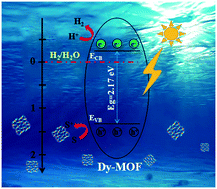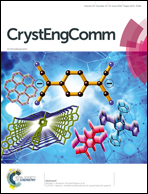Novel stable metal–organic framework photocatalyst for light-driven hydrogen production†
Abstract
A novel MOF formulated as [Dy2(abtc)(H2O)2(OH)2]·2H2O (H4abtc = 3,3′,5,5′-azobenzene tetracarboxylic acid) was successfully synthesized, in which a dye-like ligand was integrated as a photosensitizer into MOFs by the reaction with Dy3+ ions (dye-based Dy-MOF). The ultra-stable dye-based Dy-MOF possesses a HOMO–LUMO gap of 2.17 eV as determined by UV-vis spectrum with absorbed edge at 570 nm. The dye-based Dy-MOF shows high catalytic activity for the UV-vis light driven hydrogen production, attributed to the porous structure and light harvesting from the dye-like ligand. The band-edge positions of the crystals of the dye-based Dy-MOF were studied via cyclic voltammetry (CV) to further verify the principle of photocatalytic hydrogen production. Furthermore, the exceptional thermal and pH stability of the dye-based Dy-MOF makes it possible to use them as photocatalysts in water. On using Pt cocatalyst, the UV-vis light photocatalytic hydrogen evolution rate of the dye-based Dy-MOF reaches 21.53 μmol h−1 g−1. In addition, the as-prepared dye-based Dy-MOF materials also exhibited good stability and recycling performance.

- This article is part of the themed collection: Editors collection: Metal Organic Frameworks as catalysts for water splitting and CO2 reduction


 Please wait while we load your content...
Please wait while we load your content...